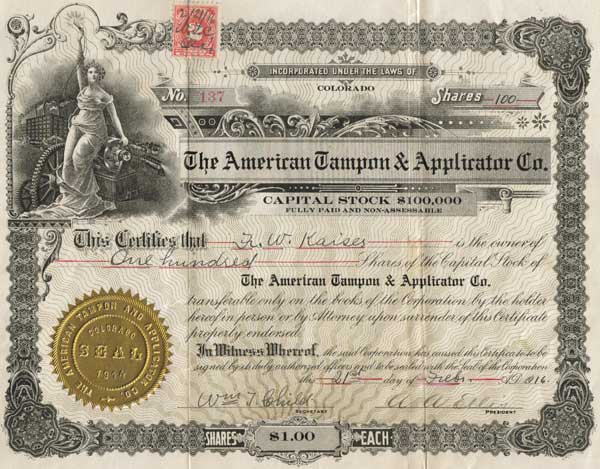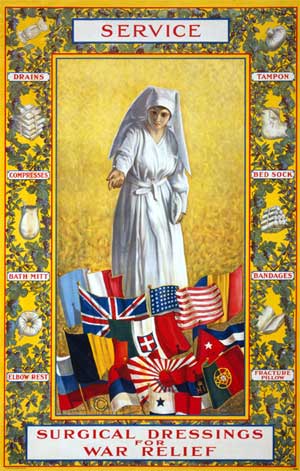See what might
be the first (or very
early) Tampax brand tampon, early 1930s- a dealer's advisory
- advice to dealers about explaining
the tampon to customers
See more
Tampax items: American ad from August 1965 - nudity in
an ad: May 1992 (United
Kingdom) - a sign
advertising Tampax during World War II - the
original patent -
an instruction sheet
from the 1930s
See a Modess True or
False? ad in The American Girl magazine,
January 1947, and actress Carol
Lynley in "How Shall I Tell My Daughter"
booklet ad (1955) - Modess .
. . . because ads (many dates)


|

Did Tampax menstrual tampons have a
little-known predecessor?
Tampax tampons made history by
allowing women to insert tampons into
their vaginas with an applicator - and
they might have been the first tampons
designed for menstruation (more here).
But were they really the first with an
applicator - or the first menstrual
tampons? The Tampax history, Small
Wonder, claims that Dr. Earle Haas
created the Tampax in the late 1920s and
early thirties after seeing the problems
his wife had with menstrual pads. (Read
genius adman Albert
Lasker's anecdote about women not
willing to buy the early Kotex.) The
Denver osteopath graduated from the
Kansas College of Osteopathy in 1918 and
practiced in rural Colorado, moving to
Denver in 1928. He was interested in
business opportunities and spent much
time working on his tampon.
Did he know of the company below?
In late 2006 I received an image of a
stock certificate - below - from a man
in Colorado who found it in some
belongings he inherited. He's related to
the person who owned the stock (and he's
embarrassed about the whole topic!). As
you see, the company called itself The
American Tampon & Applicator Co. The
stock is signed and dated 1916, the seal
1914.
Physicians traditionally used cotton
tampons - the Tampax history calls them
makeshift tampons, implying that they
were created on the spot - to absorb
fluids from wounds and to apply
medication. A poster from World War I,
below the stock certificate, shows such
a tampon at the upper right. Women often
volunteered to make such medical
dressings - applications? - for the
troops in Europe.
But the woman who has contributed many
items to MUM through her access to
genealogy data bases examined the
certificate and wrote me the following:
This stock certificate is
fascinating! I was not able to find
anything about the company, nor could
I narrow down F. W. Kaiser by just the
initials because there were too many
options. (I would need his brother's
name or something in order to find out
more about him) But I was able
to find out about the other two men,
see attached census.
In 1910 Augustus A. Ellis lives in
Denver Co. with his wife Edith. He is
a physician in general practice. He is
English-Canadian, emigrated from
Canada in 1890. By 1920 he is deceased
as Edith is widowed but still living
in Denver. This may have caused the
demise of the company together with
the cotton shortage caused by WWI.
In 1910 William T. Child is also in
Denver and is an architect. He appears
on the Denver census from 1900 until
1930, which is the latest census
available to the public so I can't go
any further. The only other thing of
note is his neighbor is also a
physician. Since this certificate is
only 100 of 100,000 shares it would be
interesting to know who some of the
other investors might be, plus I am
wondering if Wm Child's contribution
may have been the design of an
applicator. It isn't possible to tell
if it was medical or menstrual from
this but I can tell you that all the
research I have done about medical
tampons only one referred to an
applicator and it was a description of
a wooden stick to wrap the cotton
around until you formed a tampon the
size of a cigarette and that was to
put medicine on to place in the nose,
so not something I think you would
include in the company name.
The other thing that is fascinating
is it is Denver! So you have to wonder
if this was the design that was later
patented. Did the company fold and was
it up for grabs? Was the stock sold
when Dr. Ellis died? . . . I
have more questions than answers.
It may help to simply put this
information on your site and maybe
someone from Dr. Ellis or Mr. Child's
family will see it. Otherwise,
contacting a librarian in Denver who
may be able to look up something on
the architect, since he was there so
many years he must have designed some
of the historic buildings. I think it
would make a great newspaper article
if you could get the interest of a
reporter there who would have the
access to local records and that is
what you would need.
I am fascinated!
But it's possible "applicator"
referred to items separate from tampons,
maybe other devices to apply medication.
But maybe not.
In any case it looks as though there
was a company that intended to make
commercial tampons, whether for
menstruation or for medical use. Did it
ever?
|
Below: A
stock certificate for a tampon - and
applicator - company in the same town
the inventor of the Tampax tampon - and
applicator - lived and practiced. Tampax
tampons (is this the first one?)
earned their fame by combining with an
applicator, unlike other early American
'pons like Wix
and fax
and Tux (see all the tampons
on MUM).
|
 |
Below:
The poster, typical for WWI posters in
its beauty, shows items volunteers often
made for soldiers. Look at the tampon in the upper
right corner, which is maybe a
piece of cloth wrapped around cotton and
closed with string around a knot at
upper left; medical people probably used
it to apply medication or soak up
fluids from wounds.
|
 |
See what might
be the first (or very
early) Tampax brand tampon, early 1930s- a dealer's advisory
- advice to dealers about explaining
the tampon to customers
See more Tampax
items: See Tampax bulletins
from the early 1950s - Read Dr.
Dickinson's study
of the advantages of tampons over pads.
See Dutch
Tampax ads from 1938 (and here,
virtually identical to a contemporary
American ad) American ad from August 1965 -
nudity in an ad: May
1992 (United Kingdom) - a sign
advertising Tampax during World War II -
the original patent
- an instruction
sheet from the 1930s
copyright 2006 Harry Finley
|
|




